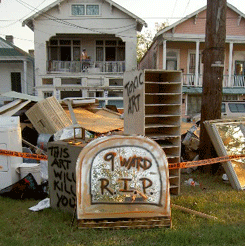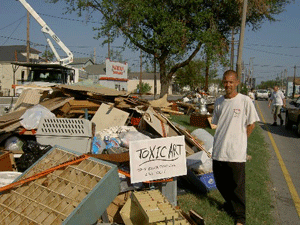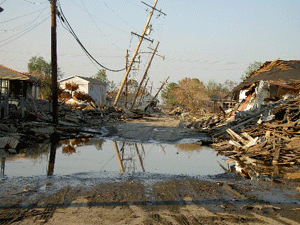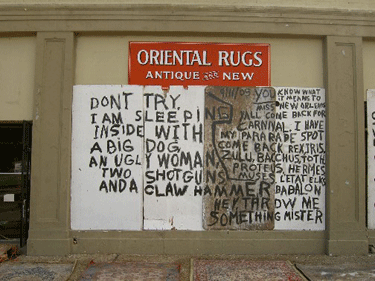Visions of a New New Orleans
Air Date: Week of October 21, 2005

(Photo: Jeff Young)
Living On Earth’s Jeff Young recently spent some time talking with New Orleaneans who rode out the storm or have returned to the city about what the future might hold. In Louisiana, Governor Kathleen Blanco has just appointed a blue ribbon panel to lead the rebuilding effort. Host Steve Curwood talks with Darryl Malek-Wiley, an environmental justice organizer with the Sierra Club, and Walter Isaacson, president of the Aspen Institute, a non-partisan think tank, and co-chair of Governor Blanco’s Louisiana Recovery Authority.
Transcript
CURWOOD: It's Living on Earth. I'm Steve Curwood. New Orleans is finally dry. The wreckage of tens of thousands of homes along the Gulf Coast is slowly being cleared. And the question arising from the havoc of Hurricanes Katrina and Rita is echoing from the Superdome to the Capitol dome in Washington: how in the world do we rebuild from such unprecedented disaster?
In Washington, promises of “whatever it takes” have begged the question, “to do what?” and the president and Congress have balked at the staggering early estimates for the cost of rebuilding. In Louisiana, Governor Kathleen Blanco has just appointed a blue-ribbon panel to help craft a vision for the southern part of the state and lead the rebuilding effort.
In a few minutes, we’ll talk with one of the leaders of that panel, as well as a New Orleans environmental justice activist who has a lot to say about what should and should not happen in and around the city. But first, Living on Earth’s Jeff Young recently spent some time talking with New Orleaneans about their hopes for their city.
[BUZZING OF FLIES]
YOUNG: Just digging out is still a big and dirty job. Flies swarm around a refrigerator, its rotting contents spilling on to the street. Towering heaps of insulation and carpeting nearly hide some houses. But New Orleans is a place with a way of turning misfortune inside out. Funerals become parades. Blues become jazz. And for artist Jeffrey Holmes, mountains of trash became art.

New Orleans artist Jeffrey Holmes arranged the flood wreckage of his gallery into an impromptu installation he calls "Toxic Art." Holmes worries that his neighborhood and others in the city’s Ninth Ward will not recover. (Photo: Jeff Young)
HOLMES: All this stuff out here that you see is all trash from the first floor that was in the water, so it’s toxic, it’s deadly. There’s black mold growing on it. It has to be destroyed.
YOUNG: Holmes arranged soggy artwork and furniture from his gallery and home in the city’s Ninth Ward into a makeshift installation in St. Claude Avenue’s median. Mardi Gras beads hang from a small field of crosses he fashioned from scrap wood. Mannequins are the mourners at a tombstone bearing the epitaph: Ninth Ward, RIP.
HOLMES: Sooner or later a bulldozer will come along and remove it all, just like lower Ninth Ward will be removed by a bulldozer.
YOUNG: Officials estimate three and a half million truckloads of waste will be hauled from the city. Much of that waste will be all that remains of many houses. Holmes worries about what will become of the artists and musicians who lived there.
HOLMES: We don’t know what’s going to happen. We know that developers are just chomping at the bit. They want the poor black people out of there so they can turn it into gated communities, condos, and planned communities. And New Orleans is not a gated or a planned community. New Orleans is a spontaneous community.

Devastation in the lower Ninth Ward of New Orleans, a low income, minority neighborhood. Many questions remain about how to rebuild here—or whether to rebuild at all. (Photo: Jeff Young)
[BOURBON STREET ACTIVITY: "It is cocktail hour…it’s always cocktail hour"]
YOUNG: In the city’s French Quarter, there is less anxiety and more optimism. The Quarter was spared most flooding, and Bourbon Street bars were open again just days after Hurricane Rita passed.
[METAL DOOR OPENING, BURGERS CRACKLING ON GRILL]
YOUNG: The kitchen was not yet working at the Three Legged Dog on Conti Street, so owner Tim Blake grilled burgers on the sidewalk. Blake says the future looks pretty good from the relatively high ground of the Quarter.
BLAKE: Historically, New Orleans is where you are right now, in the French Quarter. And as long as this old part of the city survives, I think New Orleans will keep its charm. And as long as we can get the convention center back up and running and hotels back up and running, I think we’ll be gold.
YOUNG: Blake also sees a bit of what he calls a silver lining. He points north, just past Rampart Street to the now-vacant housing projects.
BLAKE: There’s nobody there now and I feel safe right now. That’s part of that silver lining. It’s sad they get displaced, but I don’t have to deal with that right now. And the ones that come back want to work and the ones that want to work I’m not worried about. It’s the gangs. I don’t want those guys back here, man. Stay away, please. We don’t need you. You know what I’m saying? The good ones? We need them. The Quarter is full of service industry jobs that require filling. We need those people back. And the people we do have left, you could take really good care of these guys.
[BIRDS CHIRPING]
YOUNG: Just past the projects Blake points to lies the Treme area. The largely African American neighborhood is still largely empty and quiet. Resident Sean Lasalle says it’s usually alive with people and music from nearby Armstrong Park.
LASALLE: They have a lot of second lines, block parties and stuff, where everybody come and hang out. This neighborhood holds so much history and culture. It’s pretty much a very cultural neighborhood.
YOUNG: If neighborhoods like this, if they don’t come back, is New Orleans going to be New Orleans?
YOUNG: Honestly, I don’t think so, because the people give it the ambiance. We have a lot of culture, a lot of history. The people keep it alive. If you don’t have people to push it along, give it some substance, it’s history, you know? It’s just something to write in the books.
YOUNG: Lasalle’s a city native with “N.O.” tattooed on his left shoulder. He’ll stay, and he’ll probably get his bartending job back. But he’s not sure about his neighbors and whether they will come back to stay if the jobs rebuilding the city go to workers form somewhere else.
LASALLE: Quit bringing in people from other places. Give the people here a chance to clean up their own city. They don’t have work, but there’s somebody working. There’s people cleaning up all over and working. But the folks who live in this neighborhood will not have jobs. If they got to come home and stew like that, it’s gonna be bad. The attitude’s gonna go from bad to worse.
[CAR DRIVING BY, WATER SPLASHING]

Bob Rue scrawled these messages on the front of his Oriental Rug shop on St Charles Ave. Rue never left New Orleans during the storm but fears many of his fellow citizens will never return. (Photo: Jeff Young)
YOUNG: Over on St. Charles Avenue is Bob Rue’s place. It became, briefly, world famous after the storm. Rue owns Sarouk Shop Antique Oriental Rugs, and newspapers around the world carried shots of the handpainted sign he had tacked to the storefront. Rue’s message was aimed at any would-be looters.
RUE: It said ‘Don’t even try, I’m sleepin’ inside with a big dog, an ugly woman, two shotguns, and a claw hammer.’
YOUNG: I won’t ask who the ugly woman is.
RUE: Well, we have some discretion here.
YOUNG: You never left?
RUE: No, never.
YOUNG: So many people left this city. Do you think they’ll come back?
RUE: A great many people won’t, especially middle class people who went away and they’ve got their kids in school someplace else. The school system here was abysmal. People who’ve put their kids in schools in Atlanta or Houston or Dallas are realizing what schools can actually be like. They’ve gotten jobs. They’re not coming back. They’re making more money; they have a nicer apartment.
It’s like the diaspora after the flood of ‘27 in the Delta. The blues went up the river to St. Louis and Chicago and Detroit with the black people who went from the Delta. New Orleans culture has been spread across the face of America like jam on a little kid’s face. It’s not ever gonna come back.
YOUNG: It’s a pretty gloomy assessment of the city’s future, but Rue plans to stay. Before he lets the interview end, he has a request, one that hints at a bit of optimism.
RUE: Any New Orleanians out there: understand this. I got my place for the parade. I’m waiting. And I expect to see you guys come down the street. I want a parade, I don’t care if you gotta wear a milk jug over your head and a sheet, and throw peanuts and dog kibble. The carnival’s coming. Y’all know what that means: get back here. Bye.
YOUNG: This is, after all, the place where funerals become parades. For Living on Earth, I’m Jeff Young in New Orleans.
[MUSIC: File~ “Chanson de Mardi Gras” from ‘Mardi Gras Time’ (Rounder Records/EasyDisc – 1998)]
CURWOOD: With us now to discuss some of these challenges and opportunities are two people who’ve spent a good deal of their lives in New Orleans and are now in the thick of the struggle to shape and implement a vision for the future of the region.
Darryl Malek-Wiley has been involved in environmental justice issues in Louisiana for thirty years. He’s currently an environmental justice organizer with the Sierra Club and was himself swept out of his home in New Orleans by Katrina. Hello there, Darryl.
MALEK-WILEY: Hello there.
CURWOOD: And also joining us is Walter Isaacson. He grew up in New Orleans and later worked as a reporter for the Times-Picayune there before eventually rising to become managing editor of Time magazine and president of CNN. And he’s now president of the Aspen Institute, which seeks to build bridges and dialogues in an increasingly fractured world. He’s also just been named co-chair of Governor Blanco’s Louisiana Recovery Authority. Hello, sir.
ISAACSON: Hey, how are you? Thanks for having me on the air.
CURWOOD: Let’s talk about the lower Ninth Ward of New Orleans. Darryl, this is a poor, largely African American neighborhood that’s well below sea level that’s been hit hard by this. What about the basic question of rebuilding there versus doing something else for the people there? What’s your sense of their desire along those lines?
MALEK-WILEY: Well, I think the desire is mixed, you know. But you have to realize that the lower Ninth Ward, that’s one of the largest areas we have where people own their home. And they’ve got deep roots in the lower Ninth Ward, and I know it’s gonna be a complicated process figuring out who can come back, when they can come back, because of toxic issues. But I think there is a desire to come back and rebuild the lower Ninth and Holy Cross in a new way that removes some of the past problems in the area.
CURWOOD: But what about the basic issue that this is, you know, really about one of the lowest parts of the city in a place where the water is only going to get higher and higher in the years ahead?
MALEK-WILEY: Well, one of the key issues, environmental issues, is closing of the Mississippi River Gulf Outlet, or MR-GO. And that’s where the flood waters basically were pushed by both Katrina and Rita into St. Bernard and the lower Ninth Ward. So if we close MR-GO and restore the wetlands in St. Bernard we won’t have the type of flooding we had with Katrina and Rita.
CURWOOD: Walter Isaacson, the Governor of Louisiana has just asked you to help head up what is, essentially, a restoration commission. How broad a mandate has she given you, and what level of detail will you be able to address? I mean, are you gonna be able to help New Orleans answer questions like the fate of some of its poorest neighborhoods? And, if so, help them line up the resources to implement their future?
ISAACSON: What we really hope to do is set certain principles, and the first one, to answer your questions about New Orleans and lower Ninth Ward, is that we want everybody to come home. We want to make sure everybody feels welcome in the city and attract everybody back to a city that, hopefully, has a much better education system, has much better social fabric in its neighborhoods.
I grew up in the Broadmore area of New Orleans which also got flooded, and was and is a totally integrated neighborhood. I’ve moved out of New Orleans and lived in New York and Washington, which are segregated cities; I’d love New Orleans to come back with the wonderful mix that makes its culture good, its neighborhoods good, and its social fabric strong. And that means bringing everybody back.
CURWOOD: Now, how does New Orleans deal with its racial history in this? I mean, they’re really, in some respects, three races in New Orleans. You have white people, and then you have the Creole class, of what might be called people of color who have a long history of being free folks, and then you have African Americans who come from the previous plantation economy there, slavery, in Louisiana. And many of those folks really didn’t get to participate in public life until, what, the ‘60s with the Voting Rights Act?
ISAACSON: Well, I think that’s true all over America – you got people shut out of the system, especially African Americans. But in New Orleans you have a much more complex mix, and even what you just said, which is true, you have the Creoles, the African Americans, the “gentlemen of color” they used to be called in the old days. I think what you’re going to have in New Orleans is what makes it strong. What makes its food and its artistic life and its neighborhood life and its music strong is when you have a mix of social classes, a mix of racial classes, and a mix of ethnic influences that create, whether it be a great gumbo jambalaya or jazz festival or anything else.
MALEK-WILEY: That’s exactly true. I was thinking, you know, there’s a large Vietnamese community, there’s a large Hispanic community from a number of different countries; so that whole mix makes New Orleans New Orleans. I live up the river bend, and it’s an integrated neighborhood. But when I go to other cities in America I see very strong dividing lines – the poor live there, the rich live here, and never the two meet. And that makes a poorer society, a poorer culture, and we want to make sure that that doesn’t happen in New Orleans. Developers can come in here, but there is a process that they need to be listening to what the community wants and what the neighborhood wants.
ISAACSON: Let me just say “amen” to that, if I would, because I hope the listeners listening in Boston or any other place will realize the pathologies that we’re going to try to solve in New Orleans are ones that haven’t been solved in many other cities.
CURWOOD: Walter, let me ask you, this governor’s task force is obviously trying to fill a void of leadership and vision; now what does Louisiana, and the whole region, need from Washington? I mean, a lot of big promises, there’s a big price tag out there – what is it, $62 billion? Not much of it has been spent, and there seems to be, actually, a fair amount of finger pointing and bickering. What do you need from the president and Congress?
ISAACSON: Well, it’d be nice to have a coordinator or point person that would, you know, help us break through some of the red tape. But the main thing is, we’re working together right now. I had dinner with the governor who was saying some very nice things about both the president and the delegation there. We have to make sure that we can prove we can spend any money very honestly and do it openly in an open process, that we’re going to spend it wisely and prudently. We’re not going to ask for money for everything in the world, but we need the levees rebuilt, we need some temporary housing right now, and we need a good planning process so that the schools and the roads can come back. If you can give us that, we can do the rest ourselves.
CURWOOD: Darryl, what do you guys need out of Washington in your view?
MALEK-WILEY: What we need out of Washington is some leadership and vision also. What we don’t need is the effort that’s going forward in Congress to suspend environmental regulations for up to a year and a half. I mean, it’s just amazing to see what some Congressional leaders are doing to say, “well, we had this catastrophe, therefor the environmental laws are what are gonna stop us from rebuilding.” That’s totally untrue. So we need some real creative vision to think about how we’re going to rebuild New Orleans and the Mississippi Gulf Coast in a more environmentally-sustainable way, not in a developer’s view of, you know, mega-condos and casinos.
CURWOOD: Now we have in Katrina the confluence of both environmental and human catastrophe, both in terms of origins and its impact. So to what degree are the solutions to those human environmental challenges in the region linked?
ISAACSON: They’re very linked, and, unfortunately, they’re not linked at the exact same time. Because you may want to restore the coastal wetlands, I certainly think you need to do that. You need to open the Atchafalaya Basin. You need to keep the barrier islands. That’s a project that we’ve been working on for years called, you know, Coastal Restoration 2025. I don’t know that you want to wait to the year 2025 before you decide how to rebuild each neighborhood, though. We’ve got a quick emergency problem over the next two or three years of making sure everybody feels welcomed back all throughout southern Louisiana.
CURWOOD: How important is it to move quickly here? I mean, a lot of folks who moved away are starting to settle in elsewhere.
MALEK-WILEY: Well, I think we’re going to have a tension between quickness and doing it the proper way, and I think that’s a dynamic tension we’re going to have to work with. But I think every day I’ve been in New Orleans, for the last couple weeks, more and more people are coming back, more and more businesses are opening up. People, once they’re getting back and they’re talking to people who have been in New Orleans and stayed here, are finding that it’s gonna be once again a dynamic, culturally diverse, ethnically, racially diverse community that is unique in the world. And everybody will want to be in New Orleans for jazz and gumbo and beniet.
ISAACSON: Well, it’d be nice to move quickly so people can get bridge loans so they can repair their houses and repair their businesses, otherwise they’ll get settled in elsewhere. But we don’t want to rush it too hard by saying here’s some quick development plans. We want to build the type of state that everybody wants to come home to.
CURWOOD: Gentlemen, that’s all we have time for today. Walter Isaacson is the co-chair of Governor Blanco’s Louisiana Recovery Authority. Darryl Malek-Wiley is an environmental justice organizer with the Sierra Club in Louisiana. Thank you both for joining me.
ISAACSON: Thank you for having us, Steve. I look forward to seeing you down there, Darryl.
MALEK-WILEY: Yeah, thank you very much. Looking forward to meeting you Walter.
Links
Darryl Malek-Wiley bio/Sierra Club Environmental Justice Projects: Louisiana
Living on Earth wants to hear from you!
Living on Earth
62 Calef Highway, Suite 212
Lee, NH 03861
Telephone: 617-287-4121
E-mail: comments@loe.org
Newsletter [Click here]
Donate to Living on Earth!
Living on Earth is an independent media program and relies entirely on contributions from listeners and institutions supporting public service. Please donate now to preserve an independent environmental voice.
NewsletterLiving on Earth offers a weekly delivery of the show's rundown to your mailbox. Sign up for our newsletter today!
 Sailors For The Sea: Be the change you want to sea.
Sailors For The Sea: Be the change you want to sea.
 The Grantham Foundation for the Protection of the Environment: Committed to protecting and improving the health of the global environment.
The Grantham Foundation for the Protection of the Environment: Committed to protecting and improving the health of the global environment.
 Contribute to Living on Earth and receive, as our gift to you, an archival print of one of Mark Seth Lender's extraordinary wildlife photographs. Follow the link to see Mark's current collection of photographs.
Contribute to Living on Earth and receive, as our gift to you, an archival print of one of Mark Seth Lender's extraordinary wildlife photographs. Follow the link to see Mark's current collection of photographs.
 Buy a signed copy of Mark Seth Lender's book Smeagull the Seagull & support Living on Earth
Buy a signed copy of Mark Seth Lender's book Smeagull the Seagull & support Living on Earth

